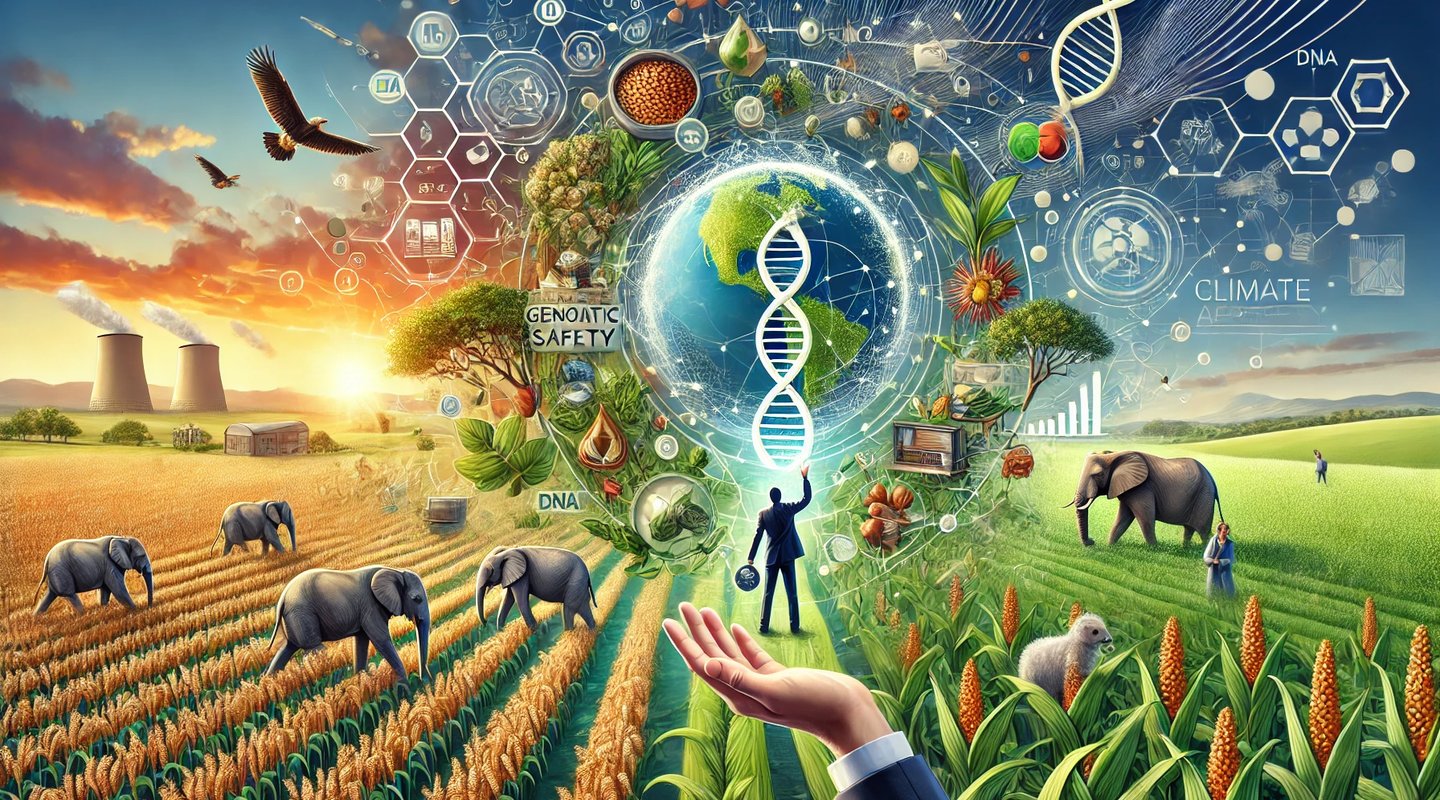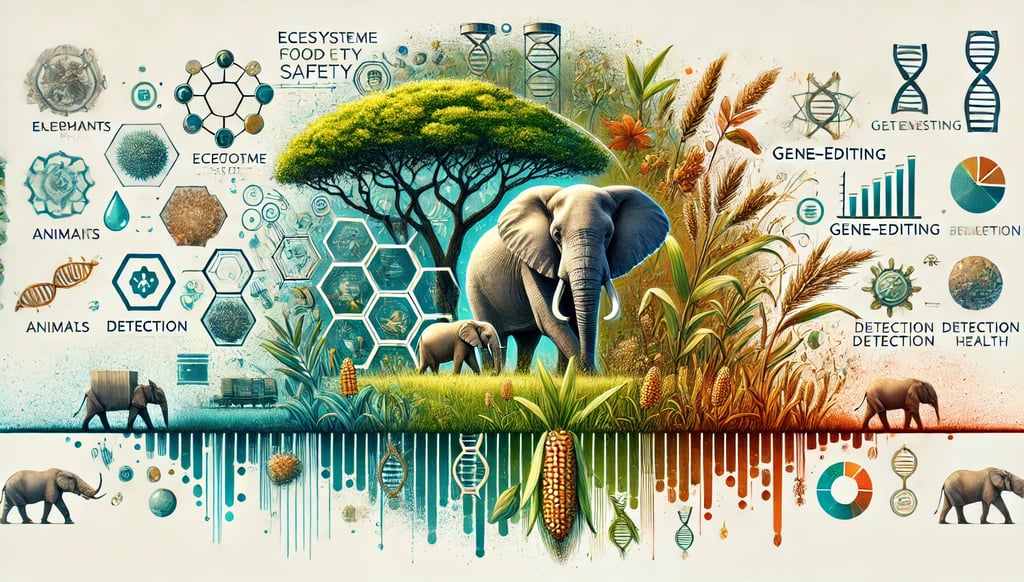Redefining Food Safety: Safeguarding Health Across Species
ECONOMIC VISION
11/14/20245 min read


PIC: ChatGPT


Health and Growth Desk
As we face the dual challenges of food security and environmental change, we must re-envision the way we approach food safety — not merely to meet today's standards but to transform them for a new era. Food safety once focused narrowly on protecting human health from pathogens and contaminants, must now integrate a multi-dimensional approach that considers wildlife, biodiversity, and ecosystem resilience as essential components of public health. The tragic case of elephant deaths in India, poisoned by naturally toxic kodo millet, reminds us that food safety’s remit is far broader than preventing human illness; it’s a keystone issue that affects entire ecosystems and could be crucial to adapting our food systems to a climate-impacted world.
This essay proposes a groundbreaking vision for food safety that combines ecology, food science, and genomics with a deep understanding of climate dynamics. This approach will not only safeguard human health but will also create a proactive, ecosystem-wide defense that mitigates the hidden yet powerful impacts of toxic substances on animals and the environment.
Beyond the Plate: Food Safety as an Ecosystem Imperative
In the traditional model, food safety starts and ends with the consumer. This model is now dangerously outdated. To achieve true food safety, we need to view every crop, pesticide, and farming practice within the context of a broader ecosystem — an ecosystem that includes humans, wildlife, pollinators, and soil organisms alike. The contamination or toxicity of food crops affects not only people but also the animals that share our agricultural landscapes.
Consider the case of kodo millet, a crop that has flourished for centuries in arid regions. While its drought resistance makes it a prime candidate for the climate-smart farming of tomorrow, kodo millet can harbor mycotoxins, like cyclopiazonic acid, that are lethal to animals and toxic to humans. Elephants, whose sensitive biology allows them to detect many toxic plants, can be deceived by mycotoxins because these compounds are odorless and tasteless. When elephants migrate through areas where kodo millet is grown, their survival is at stake, and the deaths of these elephants impact entire ecosystems, including plant species that depend on elephants for seed dispersal.
This is not an isolated problem but an ecological emergency. In the evolving world of food safety, we must develop comprehensive agricultural strategies that identify, manage, and mitigate the impact of natural toxins on all species. Protecting one species, especially in keystone animals like elephants, ripples out to protect others. Thus, we need an ecosystem-wide policy that brings new tools and novel ways of thinking to protect wildlife from agriculture-linked toxins.
Visionary Science: Engineering Crops with Purpose
The case of grass pea offers a fresh insight into the potential of advanced plant science to transform ancient crops into safer and more resilient foods. A staple in drought-prone areas, grass pea produces β-L-ODAP (ODAP), a neurotoxin that causes irreversible paralysis when consumed excessively. However, modern genomics and biochemical breakthroughs have opened up the possibility of modifying grass peas to eliminate or drastically reduce ODAP while preserving the plant's natural resilience. This insight is revolutionary: it challenges us to develop plants not merely for yield but for safety and sustainability within multi-species landscapes.
Imagine a future where we grow “intelligent” crops — plants that have been carefully designed not just for humans but for the entire ecosystem. These crops could have traits that minimize toxin formation and enhance safety for both animals and humans. For instance, gene-editing technologies could potentially disable toxin-producing pathways in plants like kodo millet or enable crops to release natural biocides only in response to pest attacks, thus reducing the need for synthetic pesticides. With such innovation, we can build safer food systems at the genetic level, integrating ecological compatibility into crop breeding itself.
Climate Resilience Meets Food Safety: A Whole-Systems Approach
As climate change accelerates, extreme weather events are increasing the risk of crop contamination with mycotoxins. Frequent, unseasonal rains create ideal conditions for fungal growth, heightening the likelihood of toxin production in food crops. Our approach to food safety must not only anticipate these risks but adapt dynamically to the changing climate.
This vision calls for climate-responsive crop management protocols that are predictive rather than reactive. By using data from satellite weather forecasts, fungal disease models, and on-the-ground temperature and humidity sensors, we can forecast mycotoxin outbreaks before they occur. Imagine a “smart” agricultural system that integrates these predictive models with AI-driven agricultural practices, where crops vulnerable to fungal toxins receive tailored interventions at critical stages, reducing contamination risks long before harvest.
Food Safety Technology in the Hands of Farmers: Democratizing Detection and Prevention
One of the most transformative ideas for the future of food safety is empowering farmers and local communities with simple, cost-effective tools for toxin detection and crop management. Until now, the technologies for identifying contaminants in food have remained inaccessible to many small-scale farmers, leaving them with limited options for detecting invisible threats like mycotoxins. By decentralizing food safety with portable toxin-detection kits, we can revolutionize how food safety is managed at the local level.
Imagine farmers in drought-prone or high-humidity areas equipped with hand-held devices that allow real-time analysis of toxin levels in their crops. Such tools would act as a first line of defense, enabling immediate actions like additional drying or enhanced storage measures that could drastically reduce mycotoxin levels in high-risk harvests. Combined with access to low-toxin crop varieties and education on climate-resilient practices, these tools could empower farmers to transform food safety at the ground level, where risks are most acute.
Who We Are:
The Economic Nations champions global unity through economic collaboration, focusing on sustainable growth, reducing inequalities, and enhancing global relationships for mutual prosperity and peace.
______________________________________
A Blueprint for Ecosystem-Based Food Safety Policy
Our current food safety policies are fragmented, with separate guidelines for humans, animals, and environmental impacts. It’s time to unify these into a single, ecosystem-based food safety framework, bringing together insights from agriculture, ecology, wildlife conservation, and climate science to address the interconnected nature of food systems. Such a policy would consider the unintended impacts of agricultural practices, aiming to safeguard biodiversity while fostering a safe food supply for all species.
This blueprint would involve several new directives:
Ecosystem Health Impact Assessments: Just as we require environmental impact assessments for construction projects, food systems should be evaluated for their impacts on local biodiversity and wildlife health.
Climate-Adaptive Food Safety Standards: These standards would create protocols for toxin management that adapt based on real-time climate data, enhancing crop safety in response to weather fluctuations.
Bio-compatible Crop Breeding Guidelines: By setting criteria for breeding toxin-reduced crops, we can encourage the development of plants that meet the safety requirements of diverse species sharing agricultural landscapes.
Farmer-Led Food Safety Councils: These councils, supported by agricultural scientists and ecologists, would give farmers a direct role in shaping food safety practices, ensuring that the solutions are practical, sustainable, and locally relevant.
Rethinking Food Safety as Ecological Resilience
This new vision of food safety isn’t just about preventing poisonings; it’s about cultivating resilience in an interconnected world. We need to treat every crop as part of a larger system that feeds not only humans but an entire web of life. By creating food systems designed to reduce harm across species and adapting them to respond dynamically to the climate, we can safeguard the health of both people and the planet. This whole-systems approach isn’t just an evolution of food safety — it’s a revolution that reshapes our relationship with agriculture, ecology, and the environment for a sustainable future.
Food safety for a climate-changed world means thinking beyond human tables. By embedding safety into every stage of the food system and engineering resilience into the very DNA of our crops, we have the power to make the fields and forests of tomorrow safer, healthier, and more harmoniously integrated with the life around them. This is the food revolution we need, and it starts with a radical rethinking of what it means to keep our food — and our world — truly safe.
PIC: ChatGPT
Contacts
enquiry@economicnations.org
(xx) 98-11-937-xxx (On verification)
